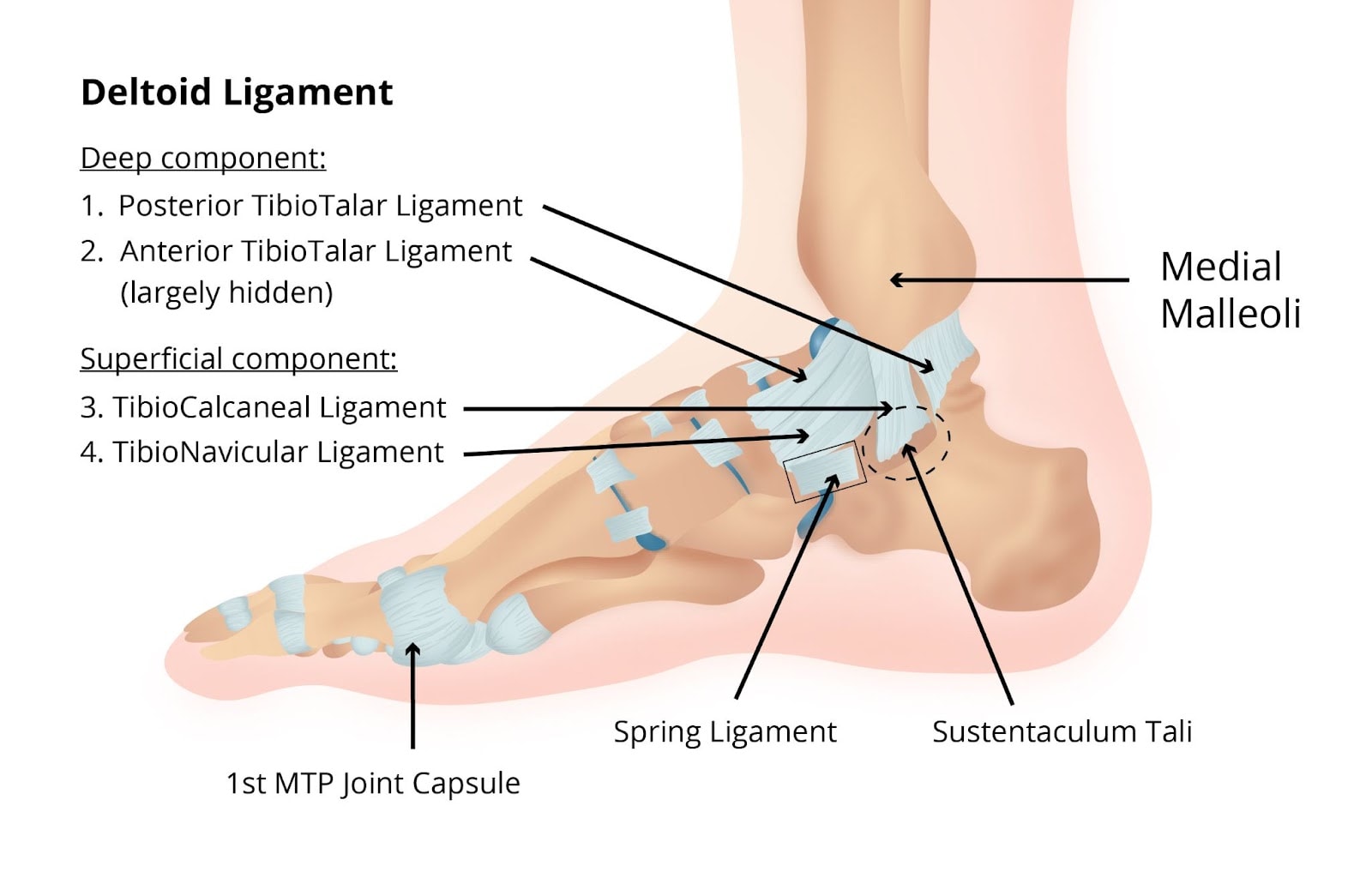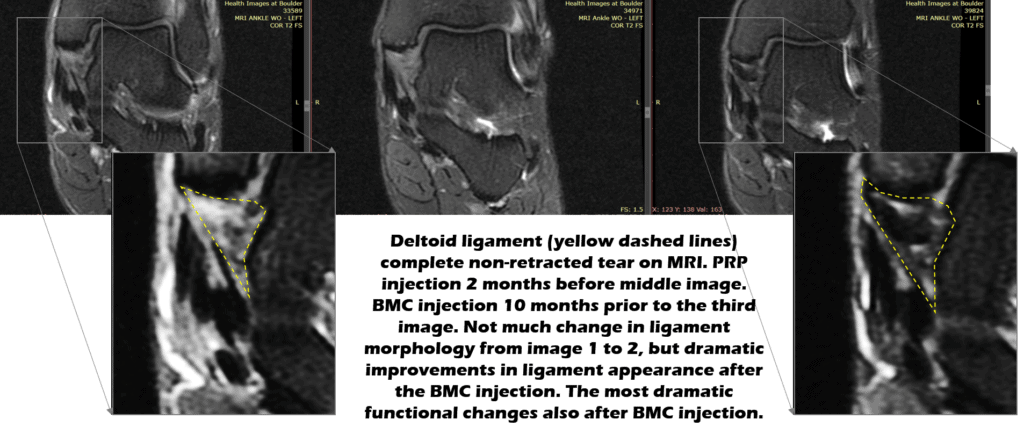Deltoid Ligament Sprain: Causes, Symptoms, And Treatment Options

Medically Reviewed By:
Deltoid ligament sprains on the inside of the ankle can cause pain and instability and limit your ability to walk or engage in daily activities. In this article, we’ll explore what causes these injuries, the symptoms to watch for, and effective treatment options, both conventional and non-surgical.
What Is the Deltoid Ligament?

Your ankle contains ligaments on both the outside and inside. The deltoid ligament, located on the inside, is often compared to a strong tape that holds the ankle bones together.
It has three main parts: the back, middle, and front sections. This ligament helps stabilize the ankle joint, particularly the tibiotalar joint (the main ankle joint) and the subtalar joint below it.
What Are Deltoid Ligament Sprains?
A deltoid ligament sprain occurs when the ligament is overstretched or torn due to excessive stress or injury. Sprains are categorized into different grades, from least severe to most severe:
- Grade 1: A mild sprain with some stretching of the ligament fibers.
- Grade 2: A moderate sprain involving partial ligament tearing, leading to reduced stability.
- Grade 3: A severe sprain where the ligament is completely torn, causing significant instability in the ankle.
In more serious cases, incomplete or complete tears may occur, requiring more intensive treatment.
- Incomplete tear: Part of the ligament is torn but remains connected.
- Complete non-retracted tear: The ligament is torn through, but the broken ends of the ligament fibers remain close together.
- Complete retracted tear: The ligament is torn in half, with the ends snapping back like a rubber band.
What Causes Deltoid Ligament Injuries?
Deltoid ligament injuries are commonly caused by trauma or overuse. Frequent causes include:
- Rolling or twisting the ankle inward: Sudden movements can overstretch or tear the ligament.
- A direct blow to the ankle: Physical trauma can damage the ligament.
- Overuse or repetitive strain: Repeated stress during physical activities can weaken the ligament over time.
- Sudden changes in direction: Quick directional shifts, especially during sports, increase the risk of sprains.
Symptoms Of Deltoid Ligament Sprains
Common symptoms of deltoid ligament sprains include:
- Inner ankle pain: Pain during movement or when pressure is applied to the inner ankle.
- Swelling and bruising: Often present after injury, especially with moderate to severe sprains.
- Difficulty bearing weight: Pain or instability may hinder walking or weight-bearing activities.
- Limited range of motion: The ankle may feel stiff, with discomfort when moving.
Diagnosis For Deltoid Ligament Injuries
A physical examination is often performed to diagnose a deltoid ligament injury, which may involve rolling the ankle outward to test the strength of the ligament. If the ligament is injured, this movement may cause pain, and a skilled physician will check for excessive motion of the joints.
Imaging techniques such as MRI, ultrasound, or X-rays may also be used. MRI scans can visualize the ligament and reveal soft tissue damage, though they are static tests. Ultrasound and movement-based X-rays offer real-time imaging, allowing physicians to see if the ligament is too loose or unstable.
Conventional Treatment Options For Deltoid Ligament Injuries
Sprains are typically treated with rest and immobilization, such as bracing, and most heal within a few weeks.
However, if the pain persists or the ankle remains unstable, further treatment options, including injections such as prolotherapy or bone marrow concentrate, may be necessary to promote healing. If the ligament is only partially torn or has a complete non-retracted tear, these injection-based therapies can often help heal the injury.
Surgical repair is usually needed if the ligament is fully retracted (snapped back like a rubber band). The procedure typically involves drilling holes and feeding a tendon to replace the damaged ligament, though this replacement will never function exactly like the original ligament.
- Splinting or bracing: Splinting/bracing stabilizes the ankle, limits movement, protects the deltoid ligament, reduces pain, and promotes healing by preventing further injury.
- Physical therapy: Once the initial pain and swelling subside, physical therapy is essential to restore strength, mobility, and stability in the ankle. Targeted exercises help improve the range of motion and prevent future injuries.
- Prolotherapy: Prolotherapy is an injection-based treatment that introduces an irritant solution to stimulate the body’s natural healing response. It is being explored for use in ligament and tendon injuries. Read More About Prolotheraphy.
- Bone Marrow Aspirate Concentrate (BMAC): Bone marrow aspirate concentrate (BMAC) is a procedure that collects and concentrates bone marrow cells, which are then used in orthopedic applications to support joint and tissue health. Read More About Bone Marrow Aspirate Concentrate (BMAC).
The Regenexx Approach For Deltoid Ligament Injuries
The Regenexx approach provides a non-surgical alternative to surgery by leveraging the body’s natural healing mechanisms to address damaged ligaments. This approach utilizes orthobiologics derived from your own blood or bone marrow to help promote tissue health.
Customized treatment plans may include one or more of the orthobiologics below.
Regenexx-SD Injectate
Procedures using Regenexx-SD injectate include a patented protocol that utilizes Bone Marrow Concentrate (BMC) which contains the patient’s own mesenchymal stem cells. The cell processing for a Regenexx-SD injectate routinely achieves 20x concentration— above what non-Regenexx cell processing can achieve.
Regenexx-SCP Injectate
Procedures using Regenexx-SCP injectate represent a supercharged version of platelet-rich plasma (PRP). In this process, blood is drawn, then processed to isolate the platelets and growth factors. The growth factors are then purified, concentrated, and injected into the ankle area using imaging guidance for precision. Regenexx-SCP injectate provides a higher concentration of growth factors compared to typical PRP procedures.
Regenexx-PL Injectate
Procedures using Regenexx-PL injectate are a highly specialized derivative of platelet-rich plasma (PRP) with a faster and more concentrated release of growth factors compared to typical PRP. The PL injectate is often combined with other orthobiologics such as PRP and bone marrow concentrate.
Julie’s Recovery Journey: Supporting Deltoid Ligament Health Without Surgery
Julie, a middle-aged avid runner, injured the inside of her ankle while playing in the surf during a vacation. Her initial MRI (shown on the far left) revealed a deltoid ligament tear. The yellow dashed lines outline the ligament, which appears whitish on the scan.
Typically, a healthy ligament appears dark on this type of MRI, so the lighter color indicates a full-thickness, non-retracted tear. This means the ligament was damaged throughout but had not snapped back like a rubber band.
[Note: It’s crucial to have an experienced non-surgical physician review the MRI films rather than relying solely on the radiologist’s report, as subtle distinctions like this may not be indicated in the report.]

Two months after receiving a PRP injection using Regenexx-SCP injectate, guided by ultrasound, Julie experienced only mild improvement. Her follow-up MRI showed that the ligament remained light-colored, indicating it was still partially torn.
Given the slow progress, she underwent a bone marrow concentrate (BMC) injection using Regenexx-SD Injectate, which involved using her own cells to help repair the ligament. This procedure was also performed with ultrasound guidance to ensure the precise placement of the BMC in the damaged area.
Following the BMC injection, Julie’s condition improved significantly. Ten months later, a new MRI (far right image) showed a nearly normal, dark-appearing ligament, reflecting substantial improvement.
Her ankle function improved, though she still aimed to return to a higher level of running. She opted for a second BMC treatment, which she would have otherwise pursued earlier.
While deltoid ligament injuries may heal on their own, non-surgical techniques such as PRP and BMC injections can significantly accelerate the healing process, which may help delay or avoid surgery. Julie’s experience is a great example of how regenerative therapeutics can help preserve the natural ligament and improve function.
Explore A Non-Surgical Approach For Deltoid Ligament Injuries
While painful and limiting, deltoid ligament injuries do not always require invasive surgery to heal. Advancements in regenerative medicine provide non-surgical alternatives, such as the Regenexx approach, which supports the body’s natural healing abilities.
Whether your injury is a mild sprain or a more severe tear, the Regenexx approach provides a path to recovery that focuses on preserving your body’s natural tissues.
If you are facing a deltoid ligament injury, explore these regenerative therapies and discover how you may be able to recover without surgery
Consult a physician in the licensed Regenexx network and find out if they may be able to help treat your ankle condition without surgery.
Get started to see if you are a Regenexx candidate
To talk one-on-one with one of our team members about how the Regenexx approach may be able to help your orthopedic pain or injury, please complete the form below and we will be in touch with you within the next business day.

Medically Reviewed By:
